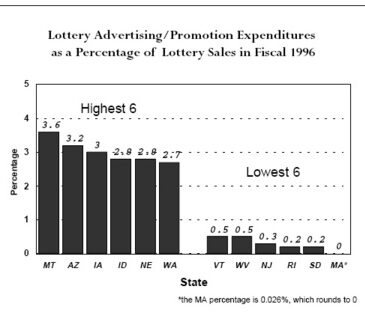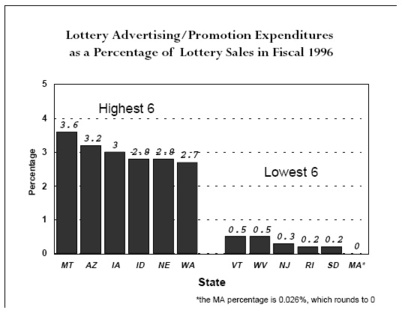During the past year, several states (30% of the states for which data was available) have decreased their budget for advertising and promoting lottery games*. Advertising implies media advertising (e.g., television or radio), while promotion includes point-of-sale, public relations, and other non-media promotion strategies. Most notably, Massachusetts cut the lottery advertising budget in half. Despite this significant decrease, however, Massachusetts increased lottery sales by 8.4%, from $2.79 billion in 1995 to $3.03 billion in 1996. The chart below* depicts, for the states with available data, lottery advertising and promotion expenditures as a percentage of lottery sales. This data is from the states with the 6 highest and 6 lowest percentages in fiscal 1996. It is easier to compare these percentages than total sales or total advertising/promotion expenditures, because they facilitate the comparison between states of different size. However, the definition of “advertising” or “promotion” for each state may differ, so comparisons still remain imprecise. In addition, state caps on lottery advertising and promotion have been managed in several ways**. For example, lottery commissions have compensated radio and television networks with lottery-printed play coupons for air time advertising. There remains a possibility, therefore, that the lottery advertising/promotion expenditure figures may underestimate the actual exposure that individuals have to the lottery. Without precise estimates of advertising/promotion expenditures, it is difficult if not impossible to determine the association between exposure to the lottery, prevalence rates of gambling, and rates of problem gambling.
Sources adapted from:
*McQueen, P. (1997, January). Making the most of a shrinking pie. International Gaming & Wagering Business, 18(1), pp. 1, 41-42, 46.
**Halbfinger, D.M., & Golden, D. (1997, February 10). Many are cashing in on the state’s coupons. The Boston Globe, 251(41), pp. A1, A8, A9.
This public education project is funded, in part, by The Andrews Foundation.





